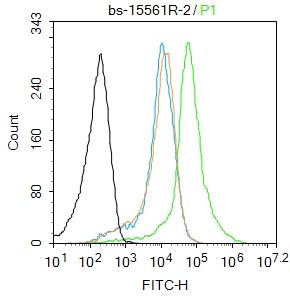IFT20 Polyclonal Antibody
Purified Rabbit Polyclonal Antibody (Pab)
- SPECIFICATION
- CITATIONS
- PROTOCOLS
- BACKGROUND

Application
| WB, IHC-P, IHC-F, IF, ICC, E |
|---|---|
| Primary Accession | Q8IY31 |
| Reactivity | Rat, Pig, Bovine |
| Host | Rabbit |
| Clonality | Polyclonal |
| Calculated MW | 15 KDa |
| Physical State | Liquid |
| Immunogen | KLH conjugated synthetic peptide derived from human IFT20 |
| Epitope Specificity | 1-100/132 |
| Isotype | IgG |
| Purity | affinity purified by Protein A |
| Buffer | 0.01M TBS (pH7.4) with 1% BSA, 0.02% Proclin300 and 50% Glycerol. |
| SUBCELLULAR LOCATION | Golgi apparatus, cis-Golgi network (By similarity). Cytoplasm, cytoskeleton, centrosome, centriole (By similarity). Cytoplasm, cytoskeleton, cilium basal body (By similarity). Note=Present at the centrosomes during the cell cycle and associated with the proximal portion of the mother centriole and the lateral aspect of the daughter centriole. Associated with basal body at the base of primary cilia (By similarity). |
| SUBUNIT | Component of IFT complex B composed of IFT88, IFT57, TRAF3IP1, IFT52, IFT27, HSPB11 and IFT20. Interacts directly with IFT57 and KIF3B/Kinesin II subunit (By similarity). Interacts with CCDC41/CEP83. |
| Important Note | This product as supplied is intended for research use only, not for use in human, therapeutic or diagnostic applications. |
| Background Descriptions | IFT20 is a gene encodes a intraflagellar transport protein important for intracellular transport. The encoded protein forms part of a complex involved in trafficking of proteins from the Golgi body, including recycling of immune signalling components (Finetti et al., PubMed: 19855387). This gene is part of a complex set of sense-antisense loci that may be co-regulated. Alternatively spliced transcript variants encoding multiple isoforms have been observed for this gene. A pseudogene of this gene is located on the long arm of chromosome 14. |
| Gene ID | 90410 |
|---|---|
| Other Names | Intraflagellar transport protein 20 homolog, hIFT20, IFT20 |
| Target/Specificity | Expressed in almost all tissues. |
| Dilution | WB=1:500-2000,IHC-P=1:100-500,IHC-F=1:100-500,ICC=1:100-500,IF=1:100-500,Flow-Cyt=2ug/Test,ELISA=1:5000-10000 |
| Storage | Store at -20 ℃ for one year. Avoid repeated freeze/thaw cycles. When reconstituted in sterile pH 7.4 0.01M PBS or diluent of antibody the antibody is stable for at least two weeks at 2-4 ℃. |
| Name | IFT20 |
|---|---|
| Function | Part of intraflagellar transport (IFT) particles involved in ciliary process assembly (PubMed:17604723). May play a role in the trafficking of ciliary membrane proteins from the Golgi complex to the cilium (PubMed:16775004). Regulates the platelet-derived growth factor receptor-alpha (PDGFRA) signaling pathway. Required for protein stability of E3 ubiquitin ligases CBL and CBLB that mediate ubiquitination and internalization of PDGFRA for proper feedback inhibition of PDGFRA signaling (PubMed:29237719). Essential for male fertility. Plays an important role in spermatogenesis, particularly spermiogenesis, when germ cells form flagella. May play a role in the transport of flagellar proteins ODF2 and SPAG16 to build sperm flagella and in the removal of redundant sperm cytoplasm (By similarity). Also involved in autophagy since it is required for trafficking of ATG16L and the expansion of the autophagic compartment (By similarity). |
| Cellular Location | Golgi apparatus, cis-Golgi network {ECO:0000250|UniProtKB:Q61025}. Cytoplasm, cytoskeleton, microtubule organizing center, centrosome, centriole {ECO:0000250|UniProtKB:Q61025}. Cytoplasm, cytoskeleton, cilium basal body {ECO:0000250|UniProtKB:Q61025}. Cell projection, cilium {ECO:0000250|UniProtKB:Q61025}. Cytoplasm, cytoskeleton {ECO:0000250|UniProtKB:Q61025}. Golgi apparatus {ECO:0000250|UniProtKB:Q61025}. Cytoplasmic vesicle, secretory vesicle, acrosome {ECO:0000250|UniProtKB:Q61025}. Cytoplasm {ECO:0000250|UniProtKB:Q61025}. Note=Present at the centrosomes during the cell cycle and associated with the proximal portion of the mother centriole and the lateral aspect of the daughter centriole. Associated with basal body at the base of primary cilia. Detected in the Golgi apparatus of round spermatids and late spermatocytes. Also detected in the manchette of step 10-12 spermatids. In step 14 spermatids, found in the basal body of the sperm tail. Localization in the manchette of elongating spermatids is dependent on SPAG17 {ECO:0000250|UniProtKB:Q61025} |
| Tissue Location | Expressed in almost all tissues. |

Thousands of laboratories across the world have published research that depended on the performance of antibodies from Abcepta to advance their research. Check out links to articles that cite our products in major peer-reviewed journals, organized by research category.
info@abcepta.com, and receive a free "I Love Antibodies" mug.
Provided below are standard protocols that you may find useful for product applications.
If you have used an Abcepta product and would like to share how it has performed, please click on the "Submit Review" button and provide the requested information. Our staff will examine and post your review and contact you if needed.
If you have any additional inquiries please email technical services at tech@abcepta.com.













 Foundational characteristics of cancer include proliferation, angiogenesis, migration, evasion of apoptosis, and cellular immortality. Find key markers for these cellular processes and antibodies to detect them.
Foundational characteristics of cancer include proliferation, angiogenesis, migration, evasion of apoptosis, and cellular immortality. Find key markers for these cellular processes and antibodies to detect them. The SUMOplot™ Analysis Program predicts and scores sumoylation sites in your protein. SUMOylation is a post-translational modification involved in various cellular processes, such as nuclear-cytosolic transport, transcriptional regulation, apoptosis, protein stability, response to stress, and progression through the cell cycle.
The SUMOplot™ Analysis Program predicts and scores sumoylation sites in your protein. SUMOylation is a post-translational modification involved in various cellular processes, such as nuclear-cytosolic transport, transcriptional regulation, apoptosis, protein stability, response to stress, and progression through the cell cycle. The Autophagy Receptor Motif Plotter predicts and scores autophagy receptor binding sites in your protein. Identifying proteins connected to this pathway is critical to understanding the role of autophagy in physiological as well as pathological processes such as development, differentiation, neurodegenerative diseases, stress, infection, and cancer.
The Autophagy Receptor Motif Plotter predicts and scores autophagy receptor binding sites in your protein. Identifying proteins connected to this pathway is critical to understanding the role of autophagy in physiological as well as pathological processes such as development, differentiation, neurodegenerative diseases, stress, infection, and cancer.


